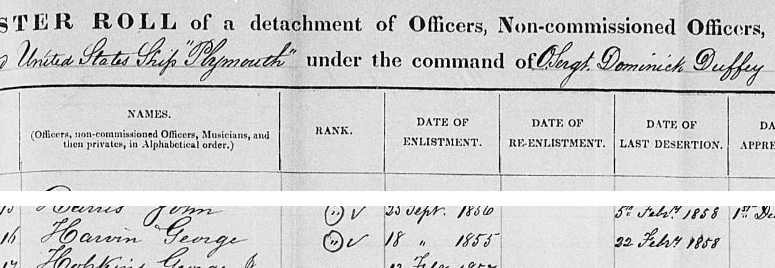 The late 1850s were a quiet time at the Washington Navy Yard. However, occasionally there was some excitement –whether it was random street violence, as we saw last week, or deserting Marines, as we have today.
The late 1850s were a quiet time at the Washington Navy Yard. However, occasionally there was some excitement –whether it was random street violence, as we saw last week, or deserting Marines, as we have today.
On February 24, 1858, the Washington Evening Star printed a Lost and Found notice regarding a missing Marine. Under the headline “$5 Reward” they said that George Harvin, a 21-year-old Marine, 5-9 ¾, blond and blue-eyed, had deserted from the USS Plymouth, stationed at the Navy Yard. The reward was to be paid out to anyone who brought Harvin back to his ship.
Harvin had been a marine almost 2-1/2 years, so he had been a youth of 18 when he had enlisted at the Marine Barracks at 8th and I. He had immediately been taken up to the Brooklyn Navy Yard, where he was posted on the sloop-of-war USS Cyane. The Cyane was about as old as Harvin, and had a busy history already, having spent some time in the Mediterranean, as well as being part of several expeditions to California which captured this land for the United States.
For the next two plus years, Harvin, aboard the Cyane, roamed as far north as Nova Scotia and south all the way to Aspinwall, as Colon, Panama, was called at the time. The latter trip was particularly exciting, as the ship was there to deliver the survivors of William Walker’s filibuster –-an attempt to gin up a revolution in Nicaragua. Walker had eventually surrendered to a US Navy commander, and while most of his men had ended up in Panama, some women, children, and invalids along with a number of officers had been left in Greytown (San Juan de Nicaragua today). The Cyane took these 142 to Aspinwall, where they were transferred to the frigate Wabash for transport back to the US.
Another trip that promised excitement, especially to Harvin and his fellow Marines, came in 1857, when Haiti was holding a number of US sailors for unspecified reasons. The Cyane‘s mission was to convince Haiti to turn over these men and take them back to the US. As it turned out, by the time the sloop arrived, the authorities had already released the men, and they were, in fact, already back home.
Early the following year, the Cyane arrived at the Gosport Navy Yard in Portsmouth, Virginia. Harvin was detached from the ship, and told to report to the Marine Barracks, Washington for a new assignment in ten days.

The muster roll from the USS Plymouth for February 1858, indicating Harvin’s unexcused absence. Note that there is space to register the Marine’s desertion as well as (not shown) the dates of apprehension and court martial as well as the offence they were eventually found guilty of. Apparently, these flights were common experiences in those years. (National Archives via Family Search)
Harvin did as ordered, then spent two week at the Marine Barracks, then, on February 18th, was told to report to the sloop-of-war Plymouth, which was a few years younger than the Cyane, but had at least as storied a career, having been part of Matthew C. Perry’s expedition to Japan. Whatever opportunities beckoned under its commander,John A. Dahlgren, Harvin was having none of it, disappearing four days later.
What happened to him is anyone’s guess. Harvin never reappears in any of the usual databases, whether military or civilian. And, in fact, he never appeared in any of them before, making it possible that his entire military career was under a false name. In any case, it looks as if nobody ever collected the five dollars promised in the Evening Star.
